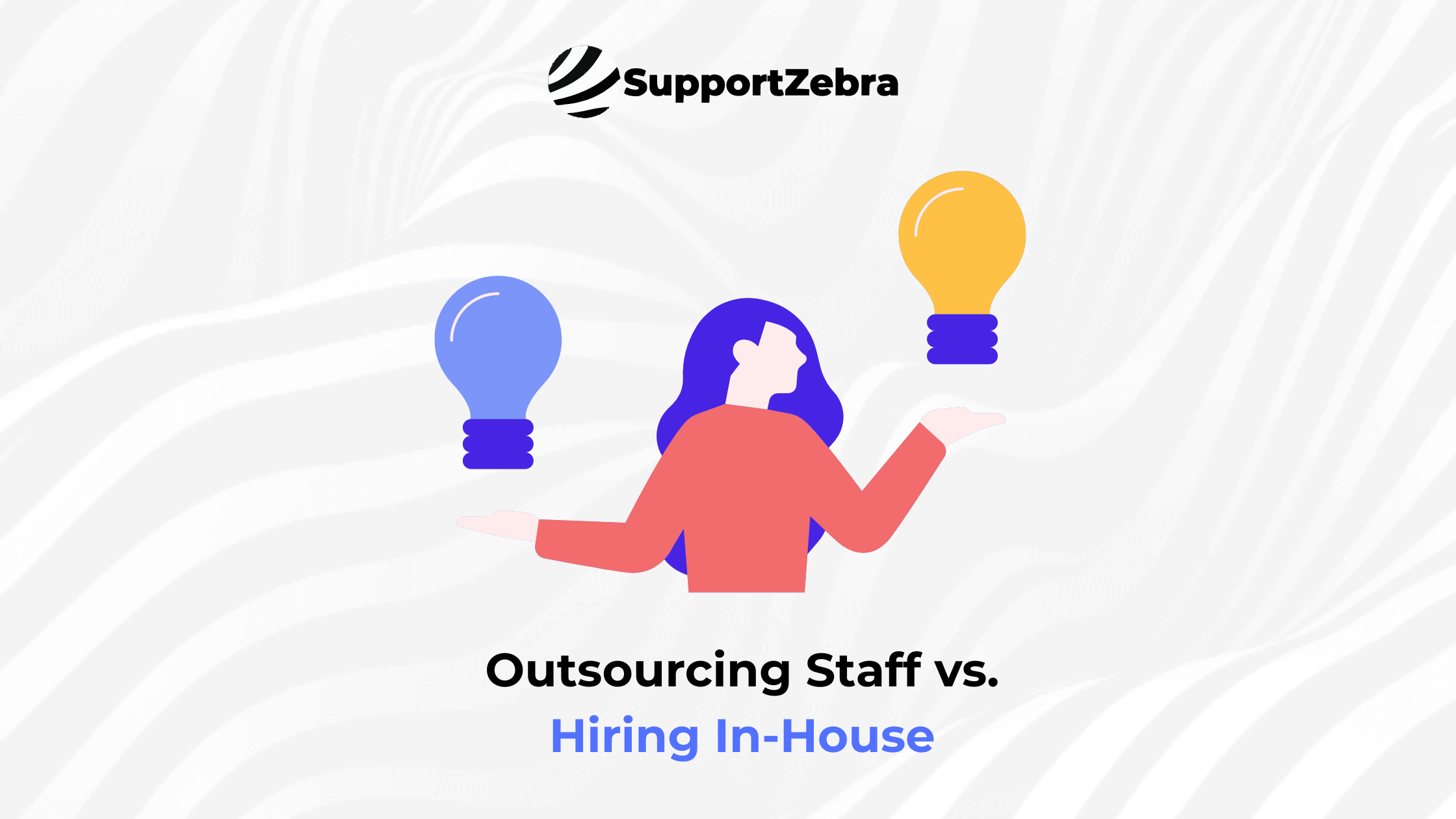The Real Costs of Outsourcing Staff vs. Hiring In-House
- Outsourcing offers cost savings and access to specialized skills, while in-house hiring provides stronger control and team cohesion.
- Both options involve visible and hidden costs—outsourcing may save money upfront but can bring communication and quality challenges.
- In-house hiring builds loyalty and culture but comes with higher salaries, benefits, and recruitment expenses.
- Partnering with SupportZebra helps businesses strike the right balance—cutting costs without compromising quality or efficiency.
When deciding between outsourcing staff and hiring internally, it’s essential to understand the costs and their impact on profits. Evaluating your staffing strategy is key to improving efficiency and service quality. Outsourcing offers a cost-effective way to access specialized skills, while in-house hiring allows for better control and team cohesion.
What is Outsourcing?
Outsourcing staff involves hiring external providers for tasks typically handled in-house, allowing companies to focus on their core competencies. Commonly outsourced services include IT support, customer service, human resources, and manufacturing, which can enhance efficiency and reduce costs.
There are three main types of outsourcing:
- Offshoring: Relocating operations to distant countries for cheaper labor (e.g., U.S. customer support in India).
- Nearshoring: Outsourcing to nearby countries to save on shipping and manage time zones (e.g., U.S. IT support in Mexico).
- Onshoring: Contracting services within the same country for better control and potential savings (e.g., payroll services in the U.S.).
Choosing the right outsourcing strategy depends on your business needs and budget.
The Costs of Outsourcing
When thinking about outsourcing staff, it’s crucial to recognize the obvious and less visible financial implications. Although saving money is a major reason for outsourcing, you must consider all aspects to determine if it’s the best choice for your company.
- Direct Financial Costs
Outsourcing involves initial costs like vendor fees, contracts, and service charges. You should also include expenses for training the outsourced employees and establishing the necessary systems. A detailed cost analysis ensures the potential savings justify these costs.
- Hidden Costs
Don’t just focus on the visible expenses—issues like communication gaps, cultural differences, and time zone discrepancies can cause delays and inefficiencies. You might also encounter quality control problems if your outsourcing partner doesn’t meet your expectations. Awareness of these hidden costs will help you understand the overall effect on your business.
- Long-Term Financial Impact
While outsourcing staff can lead to quick savings, evaluating its long-term effects is important. Relying on outside vendors and facing possible service interruptions can hinder your growth. A well-planned outsourcing approach can enable your business to adapt and innovate, but it could hold you back if not managed properly.
What is In-House Hiring?

Hiring from within your organization allows greater control over recruitment, ensuring candidates align with your company’s culture and needs. This internal approach enables your HR team to tailor job postings, interviews, and selections to meet specific objectives.
In-house hiring typically covers various roles, including:
- HR: Oversees recruitment, training, and employee relations.
- IT: Manages technical support, software, and infrastructure.
- Marketing: Creates strategies for brand promotion and content development.
- Sales: Concentrates on acquiring customers and increasing revenue.
- Finance: Handles budgeting and financial planning.
- Legal: Offers advice on contracts and compliance.
Filling these positions internally fosters specialized knowledge, enhances teamwork, and reinforces your company culture.
The Costs of Hiring In-House
When hiring in-house employees, it’s essential to understand the associated costs. While an in-house team offers better control and cohesion, the financial burden can be significant.
- Direct Costs
These include salaries, benefits, training, and overhead. Competitive salaries and benefits like health insurance and retirement plans are necessary to attract talent, and training and office-related expenses can also accumulate.
- Hidden Costs
Beyond direct costs, hidden expenses such as employee turnover, recruitment, and onboarding can arise. Advertising job openings and interviewing candidates can strain your budget, so it’s crucial to account for these in your planning.
- Long-Term Impact
While in-house hiring can enhance productivity and company culture, it carries risks like potential layoffs during economic shifts. Balancing immediate costs with long-term benefits, such as improved service quality and employee loyalty, is key to sustainable growth.
Balancing Your Budget: Outsourcing or In-House Hiring?
When deciding between outsourcing staff and hiring employees directly, weigh the pros and cons. Outsourcing offers quick savings and specialized expertise but may lead to unexpected costs and communication issues. In-house hiring provides more control and fosters teamwork but typically incurs higher upfront costs and potential hidden expenses like turnover.
To make the best decision for your staffing needs, consider what your business specifically requires and your long-term objectives. Working with a reliable outsourcing partner like SupportZebra can help you save money while still providing excellent service. Our customized solutions let you concentrate on your best work without sacrificing quality or efficiency.
Curious about how outsourcing can benefit your business? Contact SupportZebra today to learn more.

